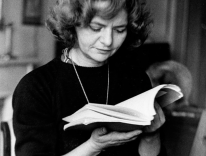Some editions of the Divine Comedy bravely attempt to forego having any notes at all, or to keep them to a minimum. Their hope is to let the poem speak for itself. The aim is noble, but with Dante the difficulties of this approach are insuperable. From the start, readers of this poem have sensed a need for help. Boccaccio’s lectura Dantis unleashed a commentary tradition that now has nearly seven hundred years of depth.
The Dartmouth Dante Project (dante.dartmouth.edu) gives us access to more than seventy scholarly commentaries from across these centuries. The founder of that project, Robert Hollander, and his wife, Jean Hollander, have now completed a translation that benefits from this scholarship. The blank verse is hers, his the introduction and a set of notes that is about thirty times the length of Dante’s text. The result is beauty and accuracy. The decision not to reproduce the rhymes of the Italian original allows the translation to stay very close to the structure of Dante’s own phrases and sentences. Yet the poetry here sings with the joy that marks the Paradiso, much as the couple’s Inferno (2000) dazzled us with the terrors of hell’s tortures and their Purgatorio (2003) taught with clarity the lessons the pilgrim received on virtue and vice.
A book this large is not likely to be anyone’s entry way to Dante. For new readers, it may be better to start with the fine translations of John Ciardi or Allen Mandelbaum. Their notes are brief and to the point, designed to give just enough help for one to follow the story.
How much detail should a commentary aim for? In medio virtus stat—in moderation stands virtue. To explain the obvious is unnecessary and boring, while to say too little is mystifying and risks leaving a reader frustrated. Since readers bring quite different amounts of background knowledge to Dante’s poem, there is no one level of commentary that is just right in the abstract. If Hollander errs, it is on the side of excess—but I do not think that he errs. The scholastic theology that Beatrice and Bernard are teaching Dante in the Paradiso is common coin for few today. So Hollander’s copious notes provide easy access to almost anything one might need or want to know in order to understand the text. His remarks on Dante’s turns of phrase and figures of speech, like his explanations of historical complexities and his suggestions for various problems of interpretation still unresolved among scholars, are ample. One need not read any of this, and yet the elaborate sets of notes at the end of the cantos stand ready, like the side galleries in the Uffizi: one can visit them with great profit, or pass by at will.
A deeper question one might pose for a joint work of literature and scholarship like this is what stance to take on questions of allegory. To my mind, the Hollanders are happily pro-allegory, in the best sense of the term. Some medieval authors launch into allegorizing so wildly that they give allegory a bad name—anything can apparently be made to stand for anything else, and we feel sure that the poet is making up connections out of whole cloth. One thinks of William Langland’s Piers Plowman, for instance, where the gems like “Chastity without Charity is like a lamp without a light” can easily get lost in the confusions of the narrative.
But Dante is different. His profound appreciation of the four levels of meaning within the Scriptures is clear from his “Letter to Can Grande,” which explains how he intended the Commedia to be read. Reminiscent of those patristic authors who used allegory and typology to work out the details of the Pauline doctrine of Christ’s recapitulation of the history of Israel, Dante’s use of allegory is all the more powerful for being so carefully reserved. The images and symbols allow the poet to explore theological topics like the relation between grace and free choice in ways that are quite different from the methods typical of Dantean sources like the theologians Peter Damian and Thomas Aquinas. But just as the narrative in the Gospels kept the patristic use of allegory rooted in revelation, so Dante’s narrative of a guided pilgrimage, together with the realism of his psychological and moral observations, keeps his creative allegorizing highly disciplined.
The present translation and notes are the culmination of a career-long project that began with Robert Hollander’s Allegory in Dante’s Commedia (1969). We are the beneficiaries of his well-trained powers of symbolic appreciation—in his interpretation of the figure of Mary as the brightest of torches in Canto 23, for instance, or in the account of the mystical rose in Canto 31. The Scriptures that often served as Dante’s model had used not only things like fire as a metaphor for the fascinating beauty and the dangerous power of love; they had also used spiritual realities like marriage, which physical objects can symbolize, to stand for yet higher realities like God’s covenant with Israel. In both the translation and the notes, the Hollanders display a wonderful attunement to Dante’s deft touches. Canto 31 of the Paradiso, for instance, begins:
In form, then, of a luminous white rose
I saw the saintly soldiery that Christ
with His own blood, took as His bride.
This vision expands for half the canto, preparing Dante, step by step, for the sight of God, which will be beyond the poet’s powers of expression. The notes accompanying this canto take us through the rose-wheel windows of medieval cathedrals and the images preferred by medieval ecclesiology. Each of Dante’s similes receives careful linguistic, literary, and theological analysis. For the Hollanders, the allegorical is always part of this poet’s vision. By virtue of their tender but rigorous handling of Dante’s profoundly symbolic narrative, the reader who has persevered into the lofty reaches of this long pilgrimage is helped to share the poet’s vision more deeply at every turn.
Related: The Sacred Poem, by Robert P. Imbelli
Please email comments to [email protected] and join the conversation on our Facebook page.
Previous Story
War Crimes?
Next Story
Giving Voice


